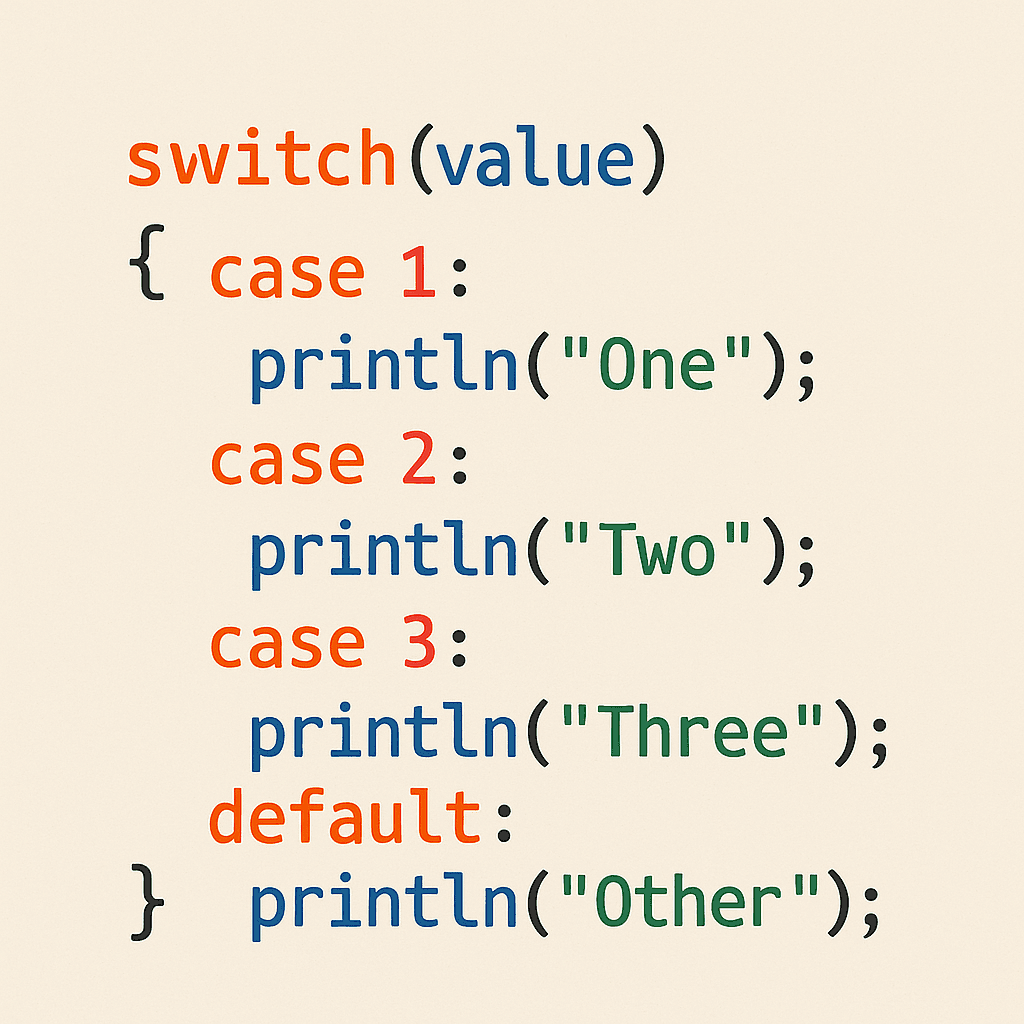Switch Statement
Why Switch?
In many programs, we need to compare a single value against several possible options.
If we try to do this using a long chain of if-else-if statements, the code quickly becomes difficult to read, maintain, and debug.
The switch statement solves this problem by providing a clean, organized structure for handling multiple possible outcomes based on one variable.
This makes the code easier to understand because:
- Each case clearly represents a specific value
- All possible choices stay grouped together
- We avoid repeating the variable inside every condition
- It improves readability and avoids clutter
Switch is especially useful for menus, category-based logic, day/month selection, command processing, and similar tasks where one value determines the result.

Example – Days of the Week
Using if-else-if (Lengthy and repetitive)
int n = 1;
if (n == 1)
System.out.println("Monday");
else if (n == 2)
System.out.println("Tuesday");
else if (n == 3)
System.out.println("Wednesday");
else if (n == 4)
System.out.println("Thursday");
else if (n == 5)
System.out.println("Friday");
else if (n == 6)
System.out.println("Saturday");
else if (n == 7)
System.out.println("Sunday");
else
System.out.println("Invalid Day");Why this is not ideal?
- You repeat the variable (
n) in every condition - The code grows longer with each new case
- Harder to scan visually
- Inefficient structure when conditions depend on the same variable
Using switch (Cleaner and more readable)
int n = 1;
switch (n) {
case 1:
System.out.println("Monday");
break;
case 2:
System.out.println("Tuesday");
break;
case 3:
System.out.println("Wednesday");
break;
case 4:
System.out.println("Thursday");
break;
case 5:
System.out.println("Friday");
break;
case 6:
System.out.println("Saturday");
break;
case 7:
System.out.println("Sunday");
break;
default:
System.out.println("Invalid Day");
}Why this is better?
- Only the values change inside each
case, not the entire condition - Code looks structured and grouped
- Easy to add, modify, or remove cases
- Clear separation of each possible output
Key Points
1. Use of break
Whenever a matching case is found, the statements inside that case run.
However, if there is no break, the execution does not stop and continues into the next case—even if that case does not match.
This behavior is called fall-through.
Example:
int n = 1;
switch (n) {
case 1:
System.out.println("Monday");
case 2:
System.out.println("Tuesday");
}Output:
Monday
TuesdayThis happens because:
- Case 1 matches and prints “Monday”
- No
break, so execution falls through to case 2 - Case 2 prints “Tuesday” even though the value does not match
Why fall-through can be risky?
- It may produce unexpected output
- Beginners often forget
break, causing logical errors - Code becomes harder to predict
But fall-through can be intentionally used for grouping cases (e.g., common output for multiple cases).
2. Use of default
The default block acts like the else in an if-else structure.
It runs when none of the cases match the value provided to the switch.
Example:
int n = 9;
switch (n) {
case 1:
System.out.println("Monday");
break;
default:
System.out.println("Invalid Day");
}Output:
Invalid DayWhy default is important?
- Ensures your program handles incorrect or unexpected input
- Prevents the switch block from doing nothing when no case matches
- Helps maintain reliability and user-friendly error messages
Summary
switchis much cleaner than writing multipleif-else-ifconditions.- Always include a break to prevent fall-through (unless intentionally required).
- The default case ensures the program behaves correctly for invalid or unhandled values.
- Switch is ideal when decisions depend on a single variable, especially when the values are distinct and known.
Written By: Shiva Srivastava
How is this guide?
Last updated on
